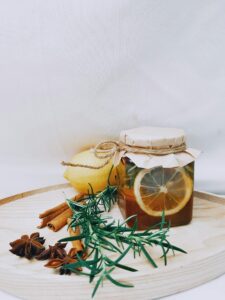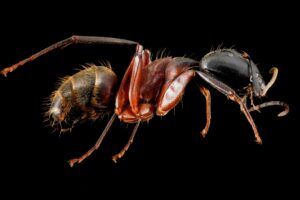Bees are vital to our food supply and natural ecosystems, they pollinate crops that produce the fruits, vegetables, and nuts we rely on. Planting forage plants not only supports honeybee health but also enhances your garden’s beauty and productivity. This guide will walk you through the best forage plants for bees, offering practical tips and insights to help you create a thriving garden.
Table of Contents

- Importance of Forage Plants for Bees
- Bee Nutrition and Health: Bees rely on a many plants to meet their nutritional needs. Diversity provides essential nutrients, including nectar for energy and pollen for protein.
- Pollination Benefits: Forage benefits from bees by creating a pollinator habitat, which helps them reproduce and results in more abundant flowers, fruits and vegetables.
- Tips for Creating a Bee-Friendly Garden
- Choosing the Right Forage: Select a mix that blooms at different times of the year to ensure a continuous food supply for bees. Native flowers are often the best choice as they are well-suited to the local environment and attract bees.
- Planting and Maintenance Tips: Clusters to make it easier for bees to forage. Ensure the plants receive adequate water, especially during dry spells. Mulching can help retain soil moisture.
- Avoiding Pesticides: Use natural pest control methods and avoid chemical pesticides, which can be harmful to bees. Consider companion planting to deter pests naturally.
- Seasonal Forage Planning
- Spring Forage: Early bloomers like crocus, dandelion, and apple blossoms provide essential food sources after the winter.
- Summer Forage: Lavender, sunflowers, and borage offer plentiful nectar and pollen during the warmer months.
- Fall Forage: Goldenrod and aster bloom late in the season, ensuring bees have enough food before winter.
The 19 Best Forage Plants for Bees
1. Lavender

Honeybee Benefits: Lavender is a favorite among bees for its high nectar content and long blooming period. The plant’s vibrant purple flower are easy for bees to spot.
When It Blooms: Lavender typically blooms from late spring to early fall, providing a resources for bees.
Honey Flavor Profile: Lavender honey is distinctly floral with a hint of fruitiness, making it a popular choice among honey enthusiasts.
Gardening Tips and Additional Info: Lavender thrives in well-drained soil and full sunlight. It’s drought-tolerant once established and requires minimal maintenance. This hardy plant is an excellent addition.
2. Sunflowers

Honeybee Benefits: Sunflowers produce abundant bee products, attracting a variety of pollinators.
When It Blooms: A bright and cheerful flower that blooms from midsummer to early fall.
Honey Flavor: Sunflower honey has light and slightly fruit taste, with a mild flavor that pairs well with many foods as a natural sweetener.
Gardening Tips and Additional Info: Sunflowers prefer full sun and well-drained soil. They are easy to grow from seeds and can reach impressive heights. Sunflowers are not only beneficial for bees but also add a sunny aesthetic.
3. Clover
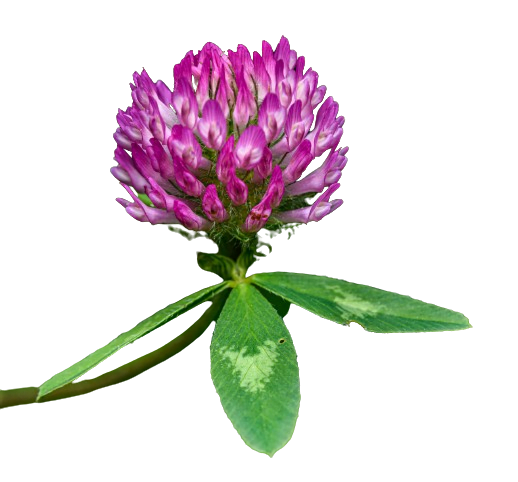
Benefit to Bees: Clover is a fantastic forage plant due to its high yield and ease of growth. It’s particularly beloved by honeybees.
When It Blooms: Clover blooms from spring through fall, offering a prolonged feeding period for bees.
Honey Flavor: Clover honey is mild and sweet with a subtle floral note, making it a staple to eat in many households.
Gardening Tips and Additional Info: Clover is easy to grow and can be used as a ground cover. It improves soil fertility by fixing nitrogen. Clover is also great for soil health as it fixes nitrogen, improving soil fertility.
4. Wildflowers
Honeybee Benefits: Wildflowers offer a diverse range of resources, supporting bee health and biodiversity.
When It Blooms: Wildflowers bloom at various times throughout the growing season, from spring to fall.
Honey Flavor Profile: Wildflower honey is complex and varies depending on the mix, typically offering a rich, multi-floral flavors.
Gardening Tips and Additional Info: Plant a mix of native wildflowers to ensure a continuous bloom period. Wildflowers thrive in various soil types and require minimal care. Planting a wildflower meadow can provide habitat for many pollinators, not just bees.
5. Blueberries
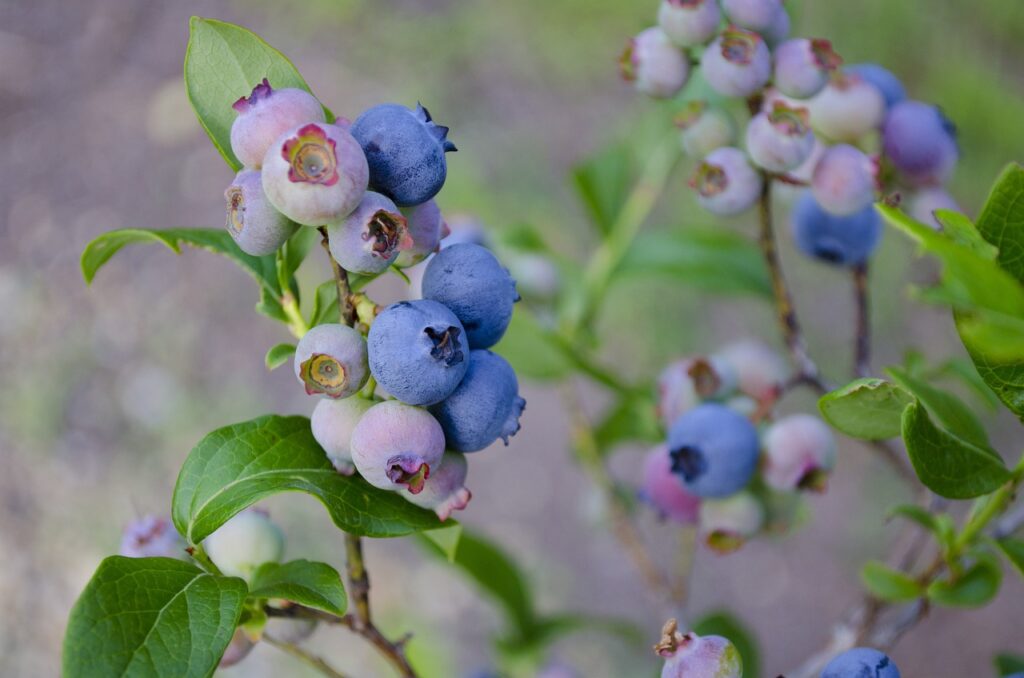
Honeybee Benefits: Blueberries are excellent for bees due to their high nectar content and the fact that they bloom early in the season when other food sources may be scarce.
When It Blooms: Blueberries bloom in early springtime.
Robust Honey: Blueberry honey is robust with a slightly tangy and fruity flavors, reflecting the berries themselves.
Gardening Tips and Additional Info: Blueberries prefer acidic soil and full sun. Regular watering and mulching help maintain their health. Blueberries also offer a tasty fruit crop for your own consumption.
6. Basil
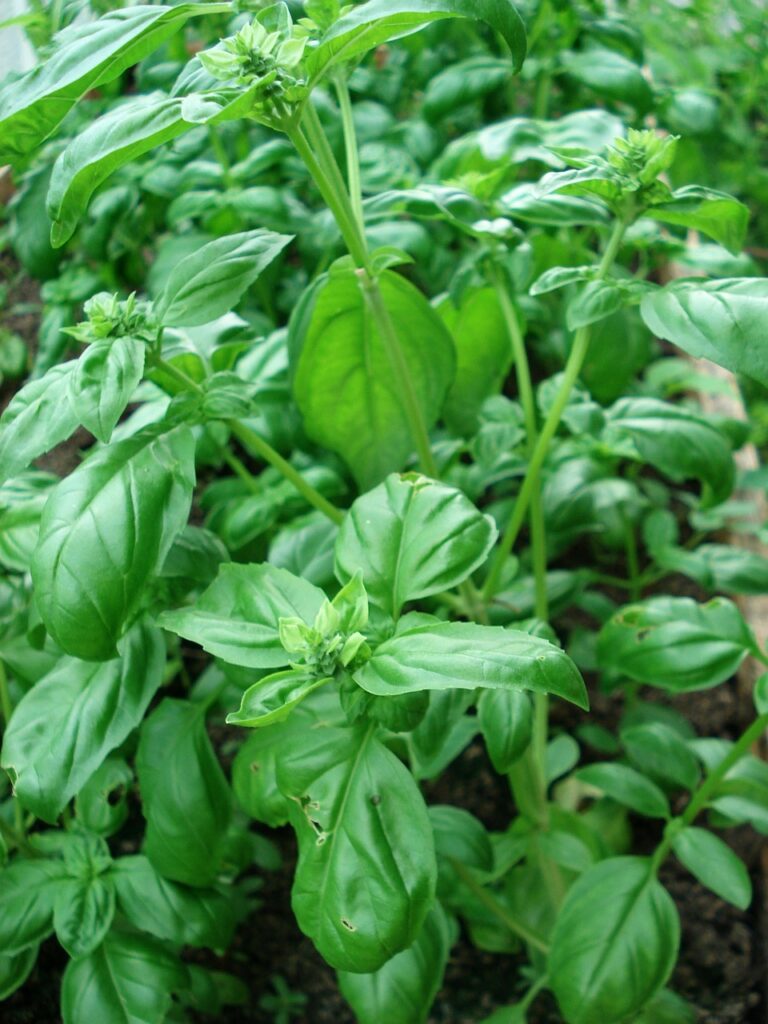
Benefit to Bees: Basil is more than just a culinary herb; its flower provides a good source of nectar for bees.
When It Blooms: Basil blooms from mid-summer to early fall.
Honey Taste: Basil honey has a mild and herbal with a hint of spiciness.
Gardening Tips and Additional Info: Basil thrives in warm, sunny conditions and well-drained soil. Regular pruning encourages more flowering. Allowing some basil plants to flower can benefit bees while still providing fresh leaves for your kitchen.
7. Apple Trees

Benefit to Bees: Apple blossoms are rich in resources, making them a key early food source for bees.
When It Blooms: Apple trees bloom in early springtime.
Honey Taste: Apple blossom honey is light and fruity, often with a delicate floral aroma.
Gardening Tips and Additional Info: Apple trees require full sun and well-drained soil. Pruning and pest control are essential for healthy growth. Apple trees not only help bees but also produce delicious fruit for you to enjoy.
8. Sage
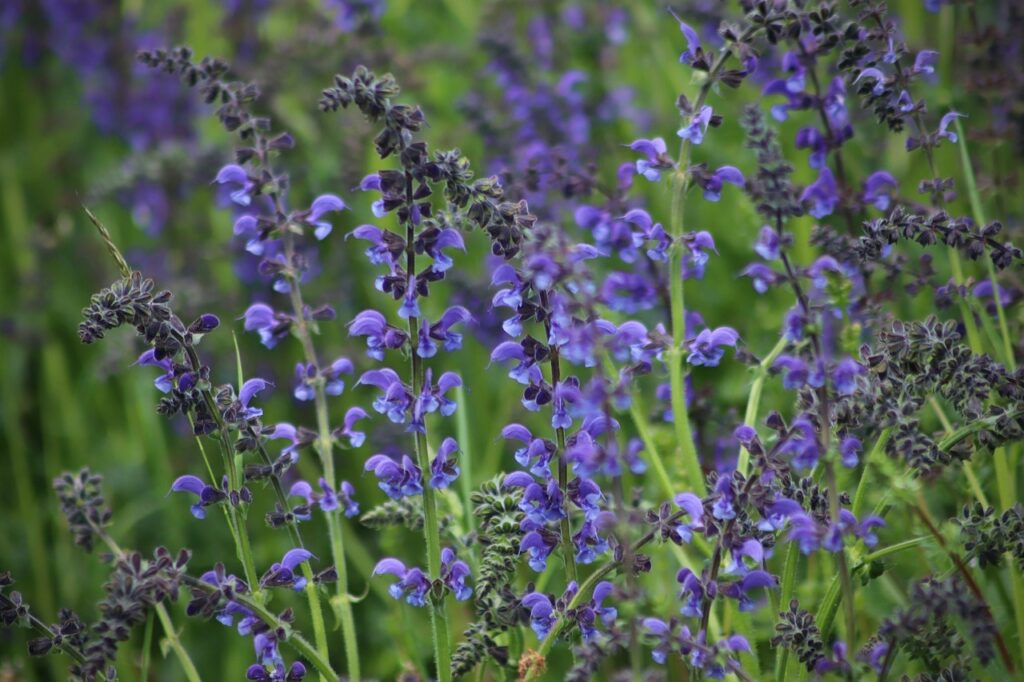
Benefit to Bees: The sage flower produces high-quality nectar that is highly attractive to bees.
When It Blooms: Sage typically blooms from late springtime to early summer.
Honey Flavor: Sage honey is light and slightly spicy with a mild sweetness.
Gardening Tips and Additional Info: Sage prefers dry, well-drained soil and full sun. It’s a hardy plant that requires little maintenance. Sage is a hardy plant that thrives in dry, sunny conditions, making it a low-maintenance choice for beekeepers.
9. Borage
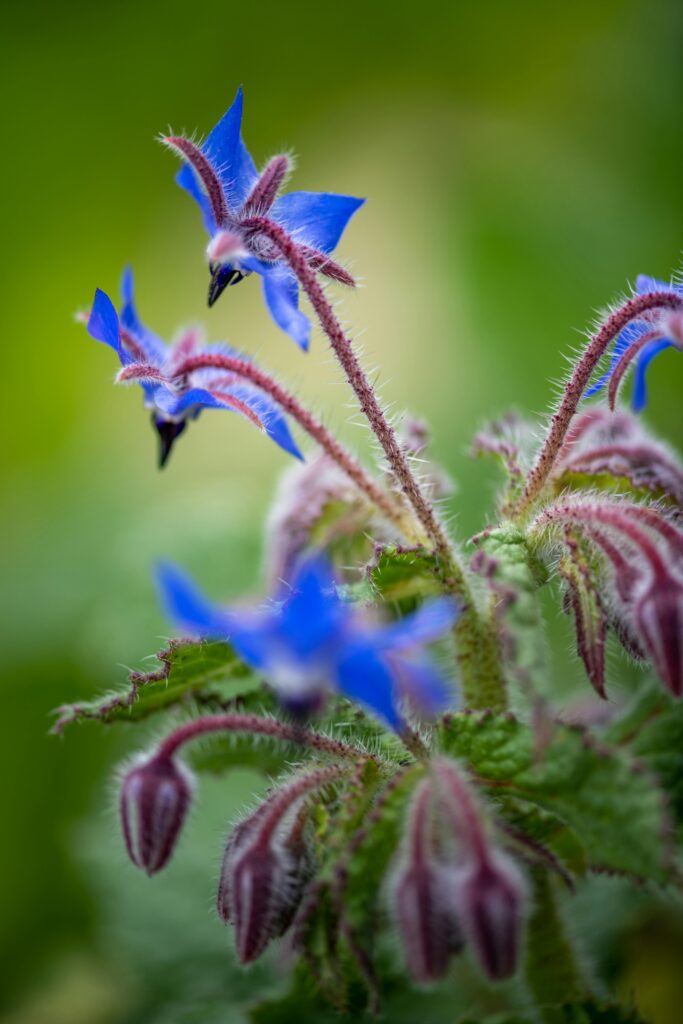
Benefit to Bees: Borage is often called the “bee plant” because it produces an abundance of nectar, making it a magnet for bees.
When It Blooms: Borage blooms from late spring to early fall.
Honey Taste: Borage honey is light and sugary with mild flavors.
Gardening Tips and Additional Info: Borage grows well in full sun and well-drained soil. It’s a self-seeding annual, ensuring it returns year after year. Borage is also an excellent companion plant, helping to repel pests and improve soil health.
10. Thyme
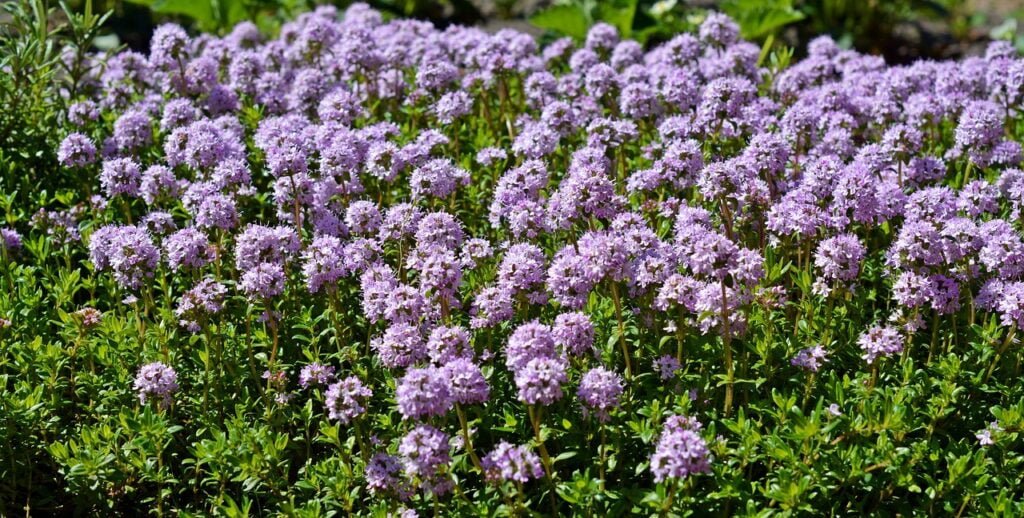
Benefits to Honeybees: The thyme flower is small but packed with nectar, providing a valuable food source for bees.
When It Blooms: Thyme blooms from late springtime to early summer.
Unique Flavor Profiles: Thyme honey has a distinctive, slightly savory flavors with herbal undertones.
Gardening Tips and Additional Info: Thyme prefers full sun and well-drained soil. It’s a low-growing plant that works well in rock and herb gardens. Thyme is a versatile herb that can be used in cooking while also supporting your local bee population.
11. Goldenrod
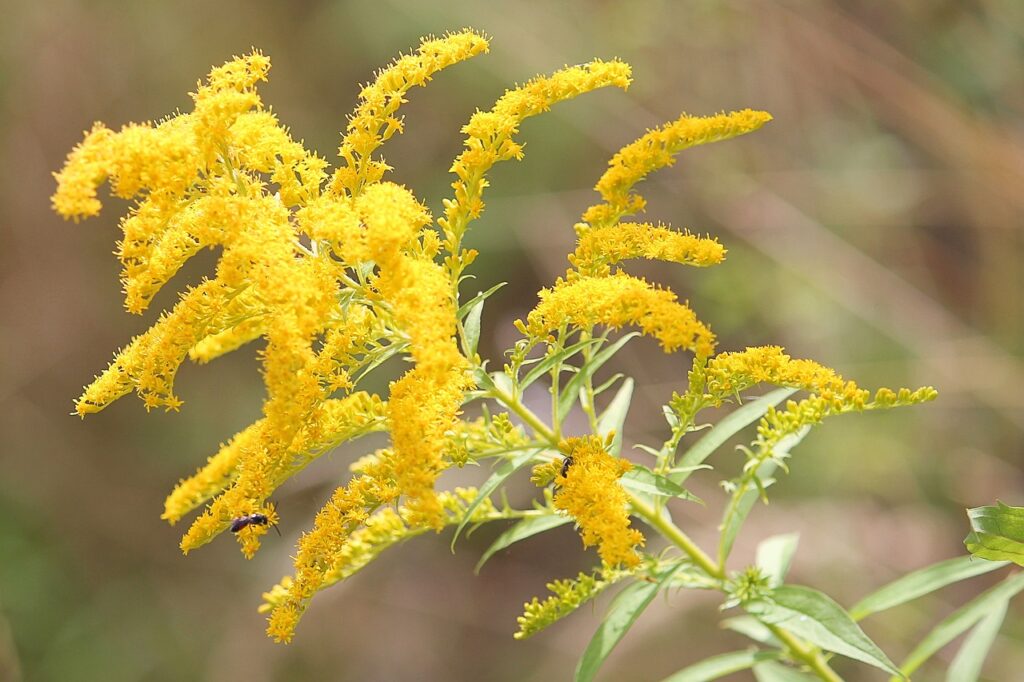
Benefits to Honeybees: Goldenrod is a late-season bloomer, providing a crucial resource when other flowers have faded.
When It Blooms: Goldenrod blooms from late summer to early fall.
Honey Profile: Goldenrod honey is dark and robust with a rich, spicy flavor.
Gardening Tips and Additional Info: Goldenrod thrives in full sun and well-drained soil. It’s a hardy perennial that can tolerate various conditions. Goldenrod is often unfairly blamed for allergies, but it’s actually a great plant for supporting pollinators.
12. Rosemary

Benefits to Honeybees: Rosemary flowers are small but produce a significant amount of nectar, attracting bees throughout its blooming period.
When It Blooms: Rosemary blooms from springtime through early summer and can bloom again in the fall.
Honey Profile: Rosemary honey is mild and herbal with a slight hint of pine.
Gardening Tips and Additional Info: Rosemary thrives in well-drained soil and full sunlight. It’s drought-tolerant and requires minimal maintenance. Rosemary is also an evergreen plant, adding year-round interest.
13. Dandelions
Benefits to Honeybees: Dandelions provide early resources, making them an important food source when other plants are not yet in bloom.
When It Blooms: Dandelions bloom from early springtime to early summer.
Honey Profile: Dandelion honey is sweet, robust, and tangy, with a bright, floral taste.
Gardening Tips and Additional Info: Dandelions are hardy and can grow in a variety of conditions. They’re often considered weeds, but their benefits to bees make them worth keeping around.
14. Mint
Benefit to Bees: Mint flowers offer resources, making them attractive to bees.
When It Blooms: Mint blooms from mid-summer to early fall.
Honey Flavor Profile: Mint honey is light, refreshing, and slightly minty, offering a unique taste.
Gardening Tips and Additional Info: Mint spreads quickly and is best planted in a contained area to prevent it from overtaking your crops. It’s a versatile herb that can be used in cooking and beverages.
15. Echinacea
Honeybee Benefits: Echinacea, or coneflower, produces a large amount of nectar and is a hardy perennial that supports bee health.
When It Blooms: Echinacea blooms from mid-summer to early fall.
Honey Flavor Profile: Echinacea honey is light, mild, and slightly floral.
Gardening Tips and Additional Info: Echinacea prefers full sun and well-drained soil. It’s a low-maintenance plant that adds vibrant color. Echinacea is also known for its healing properties, making it a beneficial addition.
16. Buckwheat (Fagopyrum esculentum)

Why Buckwheat is a Top Choice for Bees: Buckwheat is an excellent forage plant for bees due to its abundant, nectar-rich flowers. It blooms in dense clusters, making it easy for bees to collect resources.
Bloom Period: Buckwheat typically blooms from late summer to early fall. Its rapid growth and quick bloom make it a valuable late-season food source for bees.
Buckwheat Honey: The honey produced from buckwheat nectar is dark, rich, and robust in flavor, often described as malty or molasses-like. It has a unique taste that stands out from lighter honeys.
Gardening Tips and Additional Info: Buckwheat grows well in a variety of soil types and prefers full sun. It’s also a great cover crop that improves soil health by adding organic matter. It’s easy to grow and can be harvested within a few months.
17. Eucalyptus (Eucalyptus spp.)
Why Eucalyptus is a Top Choice for Bees: Eucalyptus trees and shrubs are highly attractive to bees, providing a significant resource. Their large, aromatic flowers are particularly appealing to pollinators.
Bloom Period: Eucalyptus blooms at different times depending on the species, but many varieties flower in late summer to early fall. Their extended bloom period offers a reliable food source for bees.
Eucalyptus Honey: Eucalyptus honey is known for its strong, distinctive flavor with hints of menthol and medicinal notes. It often has a dark color and a robust taste that can vary based on the eucalyptus species.
Gardening Tips and Additional Info: Eucalyptus prefers well-drained soil and full sun. It is a large tree or shrub that can grow quickly, so consider space requirements before planting. Eucalyptus leaves are also used for their curative properties and essential oils.
18. Purple Coneflower (Echinacea purpurea)
Why is it a Top Choice for Bees: Highly attractive to bees because of its vibrant, daisy-like flowers that produce abundant resources for bees. The flowers are easy for bees to access and collect from.
Bloom Period: Blooms from mid-summer to early fall, providing a consistent food source for bees during the peak of the growing season. Its extended bloom period is beneficial for bee colonies.
Purple Coneflower Honey: Mild, slightly floral taste with subtle herbal undertones. It’s light in color and has a smooth, pleasant flavor that complements various culinary uses.
Gardening Tips and Additional Info: Thrives in full sun and well-drained soil. It is a hardy perennial that requires minimal maintenance and can attract other beneficial insects. It’s also known for its medicinal purposes and use in herbal remedies.
19. Wild Bergamot (Monarda fistulosa) – Also Known as Bee Balm
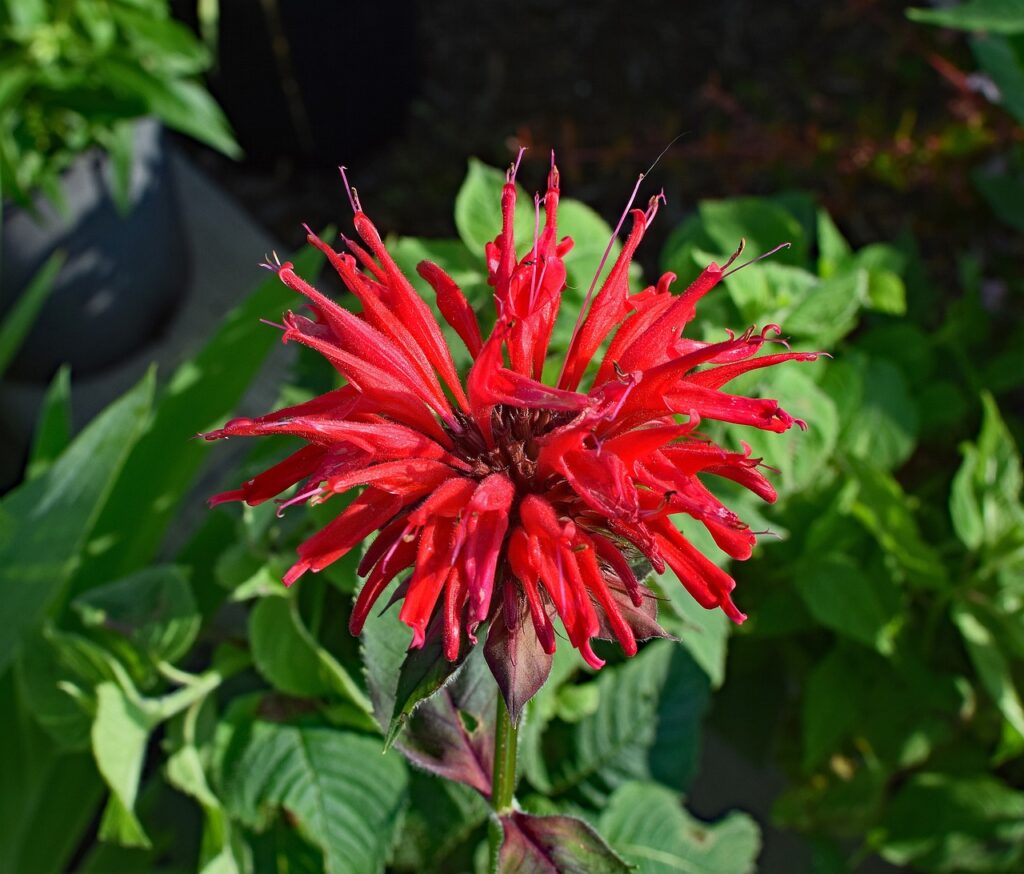
Why Wild Bergamot is a Top Choice for Bees: Wild Bergamot, commonly known as Bee Balm, is highly attractive to bees due to its vibrant, tubular flowers that produce abundant resources. Its distinctive flowers make it a favorite among pollinators.
Bloom Period: Wild Bergamot typically blooms from mid-summer to early fall. This extended bloom period provides a reliable food source for bees throughout the growing season.
Honey Taste: Honey made from Wild Bergamot nectar has a light, aromatic flavor with hints of mint and citrus. It is usually mild in taste, making it a pleasant addition to various dishes.
Gardening Tips and Additional Info: Wild Bergamot thrives in full sun to partial shade and prefers well-drained soil. It is a hardy perennial that attracts not only bees but also butterflies and hummingbirds. Additionally, it has medicinal properties and can be used in herbal teas and remedies.

- Benefits of Supporting Bees
- Environmental Impact: Bees play a critical role in maintaining biodiversity and ecosystem health. Supporting bees helps preserve these vital ecological processes and pollinate our food.
- Economic Benefits: Healthy bee populations enhance crop yields, benefiting farmers and the broader economy. Pollinators contribute billions of dollars to global agriculture.
- Common Challenges and Solutions
- Dealing with Pests: Introduce beneficial insects like ladybugs to control pests like wax moths naturally. Understanding Wax Moths: 7 Proven Facts for Every Beekeeper. Regularly inspect flora for signs of pest damage and address issues promptly.
- Weather Challenges: Protect vegetables and bees from extreme weather by providing windbreaks and ensuring they are well-watered during heatwaves.
- Frequently Asked Questions
- Q: How can I tell if my garden will support bees?
- A: A garden will have a variety of flora that bloom at different times and provide ample nectar and pollen. You’ll also notice bees visiting regularly.
- Q: What are the best plants for attracting bees?
- A: Lavender, sunflowers, and clover are among the best plants for attracting bees due to their high nectar and pollen content.
- Q: How can I support other native pollinators in addition to bees?
- A: Supporting pollinators, such as butterflies, moths, birds and beetles, involves creating a diverse and thriving garden ecosystem. Plant a variety of native flowering plants that provide resources throughout the growing season. Avoid using chemical pesticides and provide habitats such as leaf litter and undisturbed areas for pollinators to nest and find shelter. By focusing on biodiversity and crops, you’ll create a welcoming environment for all types of native pollinators.
- Q: What is a pollinator partnership and how can I get involved?
- A: A pollinator partnership is a collaboration between individuals, organizations, and communities to support and protect pollinators like bees and butterflies. You can get involved by joining local conservation groups, participating in community planting events, and creating pollinator-friendly gardens. Supporting these initiatives helps ensure a healthy environment for all pollinators.
- Q: How do pollination services benefit my garden?
- A: Pollination services enhance your garden by ensuring that a significant portion crops are properly pollinated, leading to better fruit and vegetable yields. By attracting pollinators like bees, butterflies, and other insects, you increase the efficiency of the pollination process, resulting in more vibrant and productive flora.
- Q: How can I attract honeybees and other pollinators to urban areas using a window box?
- A: To attract honeybees and additional pollinators to urban areas with a window box, a variety of flowering herbs support different species. Choose many varieties that produce resources, such as lavender, mint, and marigolds. Opt for seeds of flora that attract both bees and birds for pollination. By growing these, you’ll create a mini garden that supports pollinators and adds beauty to your space. Plus, you can enjoy fresh herbs to eat right from your window!
- Q: How can I tell if my garden will support bees?
- Resources and Further Reading
- Books and Websites: For more in-depth information, check out books like “The Bee-Friendly Garden” and websites like the Xerces Society for Invertebrate Conservation.
- Local Nurseries and Seed Suppliers: Visit local nurseries and seed suppliers to find native plants. Many nurseries offer expert advice on selection and care.
- What can you do to help bees?
- Join the Movement: Start your own garden today and share your progress on social media using hashtags like #BeeFriendlyGarden.
- Community Involvement: Get involved in local conservation efforts, join beekeeping clubs, and participate in community events to support pollinator populations.

Conclusion
Creating a haven for bees is one of the most rewarding ways to support these essential pollinators. By planting a variety of forage plants, whether you have a large garden or a small balcony, you can provide bees with the nutrients they need to thrive throughout the year. Follow the tips in this guide to attract and support bees, and start planting today to enjoy the sweet rewards of a healthy, buzzing garden. As stated by the USDA, one out of every three bites of our food, including fruits, vegetables, chocolate, coffee, nuts, and spices, is created with the help of pollinators.

